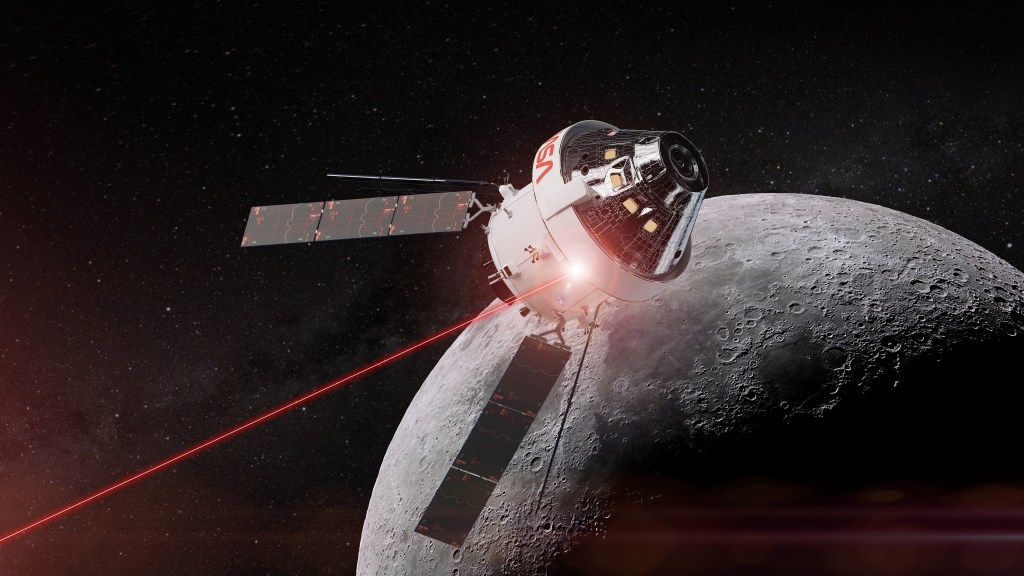Communications
Connecting Orion with Critical Services
The Artemis I mission used NASA SCaN’s Near Space Network and Deep Space Network to communicate critical data to Earth. On the launch pad and during their early orbit phases, Orion and the Space Launch System (SLS) rocket received services from the direct-to-Earth portion of the Near Space Network. After a few minutes, the mission switched to the Near Space Network’s space relay services, also known as the Tracking and Data Relay Satellite (TDRS) fleet.
Twenty-two thousand miles above Earth, the Near Space Network handed over communication to the Deep Space Network, which was Artemis I’s primary communications network during lunar orbit. Upon re-entry into Earth’s atmosphere and splashdown, the Orion capsule switched back to the Near Space Network’s relay services. The networks were seamlessly integrated at NASA’s Johnson Space Center in Houston, where network engineers coordinated the hand overs. This mission was a perfect example of NASA SCaN’s two networks working hand-in-hand.
Search & Rescue
Bringing Explorers Home
In addition to network support, SCaN’s Search and Rescue (SAR) office also played a big role during the Artemis I splashdown.
SAR team members were on the USS Portland Naval ship and used their newly developed SAR Intelligent Terminal (SAINT) to track Orion’s location beacons as it splashed into the Pacific Ocean. This allowed NASA teams to locate and retrieve the capsule.

Artemis II Search and Rescue
ANGEL Beacons: Guardian Angels for Artemis II
The Artemis II crew will be the first users of the Search and Rescue team’s Advanced Next-Generation Emergency Locator (ANGEL) beacons. These miniaturized beacons will be attached to astronauts’ life preserver units. When astronauts splash back down to Earth — or in the unlikely event of a launch abort scenario — these beacons will alert first responders to the location of the astronauts if they need to egress from the Orion capsule.
Read More
Laser Communications Demonstration
More Data Means More Discoveries
Currently, most NASA missions use radio frequency communications to send data to and from spacecraft. As space missions generate and collect more data, the need for enhanced communications capabilities becomes paramount. Laser communications uses infrared light and can pack significantly more data into each transmission than standard radio systems.
During Artemis II, SCaN’s Orion Artemis II Optical Communications System (O2O) will demonstrate the benefits of laser communications by transmitting 4K, ultra-high-definition video from the Moon along with flight procedures, pictures, science data, and voice loops.
While Artemis II’s primary communications support is the Near Space and Deep Space networks, O2O is a key demonstration of laser communications capabilities.

Other Lunar Efforts

LunaNet
LunaNet aims to bring internet-like connectivity to the lunar region so users on or at the Moon can seamlessly communicate with each other and Earth. LunaNet is an internationally coordinated framework for interoperability. The LunaNet concept is based on a structure of mutually agreed-upon standards, protocols, and interface requirements that will enable interoperability across multiple organizations.

LunaSAR
SCaN’s Search and Rescue team is developing the Lunar Search and Rescue (LunaSAR) concept and extending the best practices of current Earth-based rescue systems to the lunar surface. LunaSAR will extend ANGEL beacon usability from Earth to the lunar surface, enabling rapid response to potential distress situations on the Moon.

LuGRE
In 2024, as part of the NASA Commercial Lunar Payload Services (CLPS) initiative, Firefly Aerospace will land the “Blue Ghost” lander on the lunar surface. Onboard is SCaN's Lunar GNSS Receiver Experiment (LuGRE) which will investigate whether signals from two GNSS constellations can reach the lander and provide precise navigation on the Moon.

Lunar Time
NASA will coordinate with U.S. government stakeholders, partners, and international standards organizations to establish a coordinated lunar time (LTC) following a policy directive from the White House in April. The agency’s SCaN program is leading efforts on creating a coordinated time, which will enable a future lunar ecosystem that could be scalable to other locations in our solar system.




































